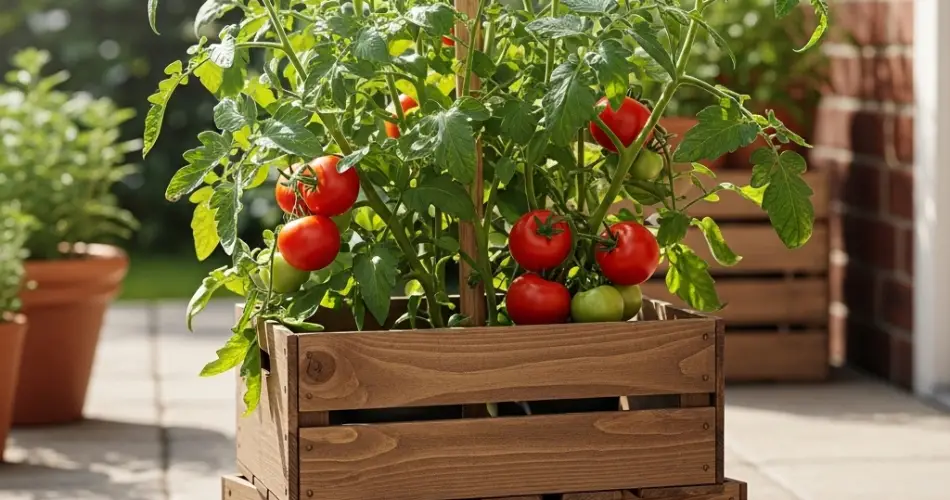Growing tomatoes in wooden boxes is a simple and effective way to enjoy fresh, homegrown produce, even in small backyard spaces. This rustic approach combines charm with functionality, allowing gardeners to control soil quality, drainage, and plant support while producing healthy, flavorful tomatoes. Whether you have a compact yard, patio, or balcony, tomato boxes make gardening accessible and rewarding.
Why Grow Tomatoes in Boxes
Tomatoes are versatile plants that thrive when given adequate sunlight, nutrition, and proper support. Traditional in-ground planting can be challenging if your soil is poor, compacted, or prone to pests. Wooden boxes solve these problems by creating a contained environment where you can provide ideal conditions.
Benefits of using boxes for tomatoes:
-
Space-efficient: Perfect for small backyards or urban gardens.
-
Soil control: Create a nutrient-rich, well-draining mix.
-
Better drainage: Reduces the risk of root rot.
-
Ease of maintenance: Watering, pruning, and harvesting are simpler.
-
Pest management: Raised boxes reduce exposure to ground-dwelling insects.
Selecting the Right Box
Choose a box that provides enough space for tomato roots to develop and support the weight of mature plants.
Guidelines for selecting a tomato box:
-
Depth: At least 12–16 inches for adequate root growth.
-
Material: Use untreated wood to avoid chemicals.
-
Drainage: Drill holes in the bottom for excess water to escape.
-
Sturdiness: Ensure it can hold soil and fully grown tomato plants without warping.
Line the inside with landscape fabric or burlap to keep soil contained while still allowing drainage. Elevate the box slightly with bricks or blocks to improve airflow and prolong the wood’s lifespan.
Choosing Tomato Varieties
The type of tomato you plant will depend on your preferences and the available space.
-
Indeterminate (vining) varieties: Grow tall, produce fruit throughout the season, and work well with vertical supports.
-
Determinate (bush) varieties: More compact and suitable for smaller boxes or limited space.
-
Cherry tomatoes: Quick-growing and ideal for snacking or salads.
-
Beefsteak and Roma tomatoes: Produce larger fruits for slicing and cooking.
Compact or dwarf varieties are especially suited for smaller boxes, while vining varieties benefit from vertical trellising.
Preparing the Soil Mix
Tomatoes require fertile, well-draining soil to thrive.
Recommended soil mix for boxes:
-
40% high-quality potting soil
-
40% compost or aged manure for nutrients
-
20% perlite or coarse sand for drainage
Incorporate a slow-release organic fertilizer to provide consistent nutrients throughout the season. Adding crushed eggshells or a calcium supplement can help prevent blossom end rot.
Planting Steps
-
Start seedlings indoors 6–8 weeks before the last frost or purchase healthy transplants.
-
Fill the box with soil mix, leaving 2–3 inches from the top.
-
Plant one tomato per box for optimum growth. Bury the stem deeply to encourage additional root development along the lower portion.
-
Water thoroughly to help settle the soil around the roots.
Supporting Tomatoes Vertically
Tomatoes benefit from vertical growth to improve airflow and sunlight exposure.
-
Use stakes, cages, or trellises secured inside or alongside the box.
-
Tie stems loosely to the support as they grow to prevent damage.
-
Prune regularly by removing suckers to focus energy on fruit production.
Rotate boxes periodically to ensure even sunlight on all sides of the plants.
Sunlight and Watering Requirements
-
Tomatoes need 6–8 hours of direct sunlight daily. Place boxes in the brightest location.
-
Water consistently at the base to maintain even moisture. Avoid overhead watering, which can promote fungal diseases.
-
Mulch with straw or shredded leaves to retain moisture and regulate soil temperature.
Feeding and Fertilizing
Feed tomatoes with a balanced fertilizer every 2–3 weeks until flowering. Once flowers appear, switch to a fertilizer higher in potassium and phosphorus to promote fruiting. Avoid excessive nitrogen, which encourages leafy growth at the expense of fruit production.
Pest and Disease Management
Boxes reduce some risks but vigilance is still necessary:
-
Aphids: Spray with water or neem oil.
-
Tomato hornworms: Remove by hand or introduce natural predators.
-
Blight: Ensure good airflow and water at the soil level, avoiding wet leaves.
Harvesting Tomatoes
-
Pick fruit when fully colored and slightly soft to the touch.
-
Use scissors or pruners to cut tomatoes from the vine, leaving a short stem attached.
-
Regular harvesting encourages continued flowering and fruiting.
End-of-Season Care
Remove spent plants and refresh the soil in the box before replanting next season. Compost healthy plant material and replace the old soil to maintain fertility. Boxes can also be moved indoors or into a greenhouse to extend the growing season.
Final Thoughts
Growing tomatoes in wooden boxes combines practicality and rustic charm while making the most of small spaces. This method offers better control over soil, drainage, and sunlight exposure, producing healthy plants and abundant fruit. Whether you’re growing cherry tomatoes for snacks or larger varieties for cooking, box gardening ensures a productive and enjoyable harvest right in your backyard.



